
Giovanni Battista Moroni was an Italian painter of the Mannerism. He also is called Giambattista Moroni. Best known for his elegantly realistic portraits of the local nobility and clergy, he is considered one of the great portrait painters of the Cinquecento.
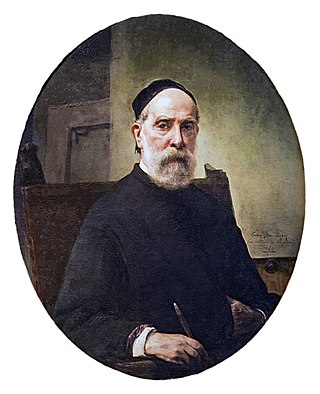
Francesco Hayez was an Italian painter. He is considered one of the leading artists of Romanticism in mid-19th-century Milan, and is renowned for his grand historical paintings, political allegories, and portraits.

Albino is a comune in the province of Bergamo, in Lombardy, northern Italy. It is located northeast of Bergamo and is situated in the valley of the river Serio. The comune is included in the perimeter of the Alpine Convention international treaty.

Gian Paolo Lomazzo was an Italian artist and writer on art. Praised as a painter, Lomazzo wrote about artistic practice and art theory after blindness compelled him to pursue a different professional path by 1571. Lomazzo's written works were especially influential to second generation Mannerism in Italian art and architecture.

Fra’ Galgario, born Giuseppe Vittore Ghislandi, and also called Fra’ Vittore del Galgario, was an Italian painter, mainly active in Bergamo as a portraitist during the Rococo or late-Baroque period.

Giovanni Giacomo Barbelli was an Italian painter of the Baroque period, active in Lombardy. He was a canvas and fresco painter known for his religious and mythological scenes that decorated many churches and residences in Lombardy. He was a highly skilled draughtsman and a brilliant colorist. His work shows an inventive imagination and a thorough knowledge of perspective.

Bartolomeo Cavarozzi (1587–1625), occasionally referred to as Bartolomeo Crescenzi, was an Italian caravaggisti painter of the Baroque period. Cavarozzi's work began receiving increased admiration and appreciation from art historians in the last few decades of the 20th century, emerging as one of the more distinct and original followers of Caravaggio. He received training from Giovanni Battista Crescenzi in Rome and later traveled to Spain alongside his master for a few years where he achieved some renown and was significant in spreading "Caravaggism" to Spain before returning to Italy. His surviving works are predominantly Biblical subjects and still-life paintings, although older references note he "was esteemed a good painter especially of portraits".
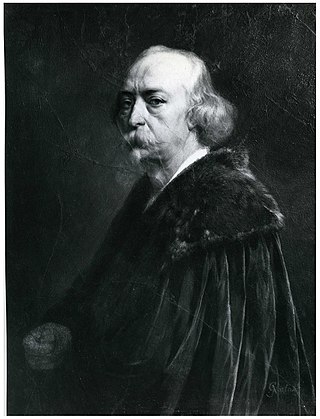
Andrea Gastaldi was an Italian painter, primarily of historical canvases and portraits.

The Tailor is an oil on canvas painting by Italian painter Giovanni Battista Moroni, from 1565-1570. It is a portrait of a member of the Marinoni family, who has been traditionally taken to be a tailor practising his art during the work day. The painting is held in the National Gallery, in London.
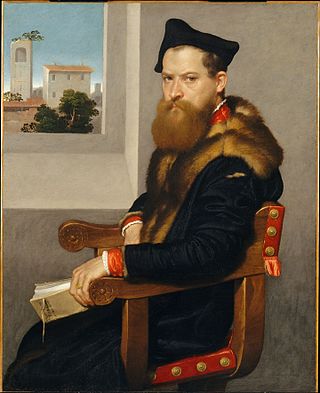
The Portrait of Bartolomeo Bonghi is an oil on canvas portrait by Italian artist Giovanni Battista Moroni, created in 1553. It is held at the Metropolitan Museum of Art, in New York. It depicts Bartolomeo Bonghi, a 16th-century Italian legal scholar. The portrait presents its subject as he was in life; a man of wealth and status. The buildings seen in the top left-hand corner of the painting identify the site of the portrait's sitting as Bergamo in Lombardy.
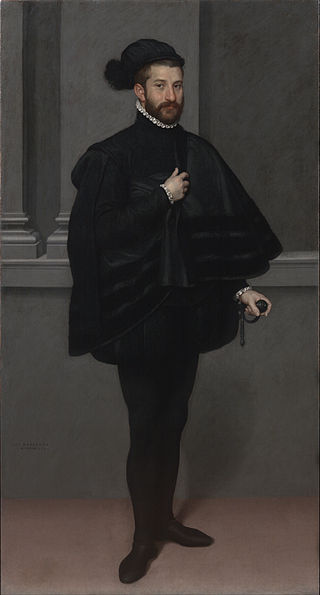
The Knight in Black is an oil on canvas portrait painting of an unknown male subject by Giovanni Battista Moroni, from c. 1567. It is held in the Museo Poldi Pezzoli, in Milan.
Simone Facchinetti is an Italian art historian.

Mystic Marriage of Saint Catherine or Mystic Betrothal of Saint Catherine is a 1567-1570 oil on panel painting by Giovanni Battista Moroni, produced for the side-altar of Catherine of Alexandria in the church of San Bartolomeo, parish church of Almenno San Bartolomeo, where it still hangs. It is signed at lower right IO:BAP.MORONUS.P. The church had been begun in 1520 through the will of Giorgio Rota, but work lapsed until restarting in 1562. The painting draws on the composition of Moretti's 1539 Rovelli Altarpiece.

Count Guglielmo Lochis was an Italian nobleman, politician, art collector and art connoisseur.
Cesare Alpini is an Italian art historian. Born in Crema, Lombardy, he specialises in art from that city and Lombardy more widely. He is most notable for his contributions to scholarship on Giovanni Battista Lucini and Gian Giacomo Barbelli. He has collaborated on several art exhibitions held in Crema, including Pittura sacra a Crema dal '400 al '700 (1992), L'estro e la realtà (1997), Officina Veneziana (2002) and Luigi Manini (2007).

Lucia Albani Avogadro was an Italian poet, member of the Albani family.

The Portrait of Alessandro Vittoria is an oil on canvas painting created by Italian painter Giovanni Battista Moroni, in 1551–1552. It is held at the Kunsthistorisches Museum, in Vienna.

The Portrait of a Man Holding a Letter, also known as The Lawyer, is an oil on canvas painting by Italian painter Giovanni Battista Moroni, from 1570-1572. It is held at the National Gallery, in London. It is considered one of the most representative paintings of the artist's maturity.

Portrait of a Lady, also known as The Lady in Red is an oil on canvas painting by Italian painter Giovanni Battista Moroni, from c. 1556–1560. It is believed to depict Countess Lucia Albani Avogadro, a 16th-century Italian poet. It is held in the National Gallery, in London.
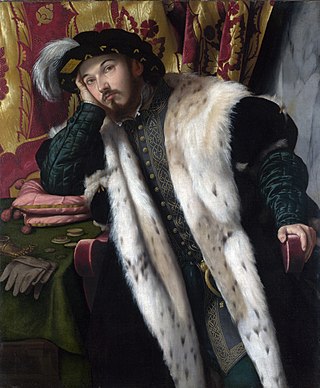
The Bergamasque and Brescian Renaissance is one of the main variations of Renaissance art in Italy. The importance of the two cities on the art scene only expanded from the 16th century onward, when foreign and local artists gave rise to an original synthesis of Lombard and Venetian modes, due in part to the two cities' particular geographical position: the last outpost of the Serenissima on the mainland for Bergamo and a disputed territory between Milan and Venice for Brescia.


















